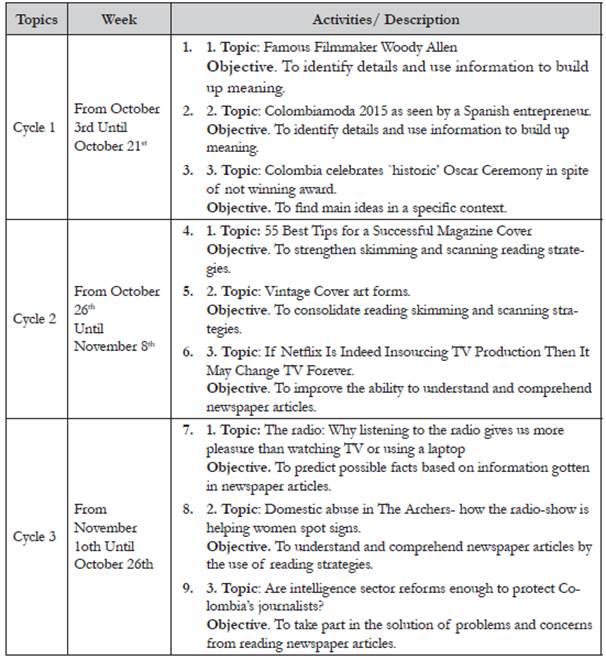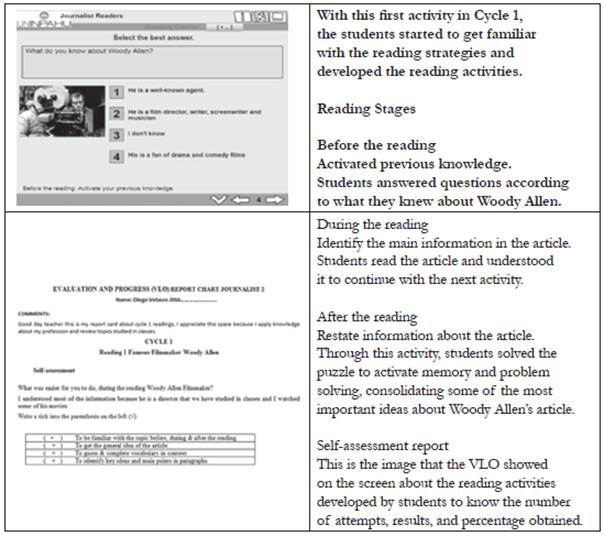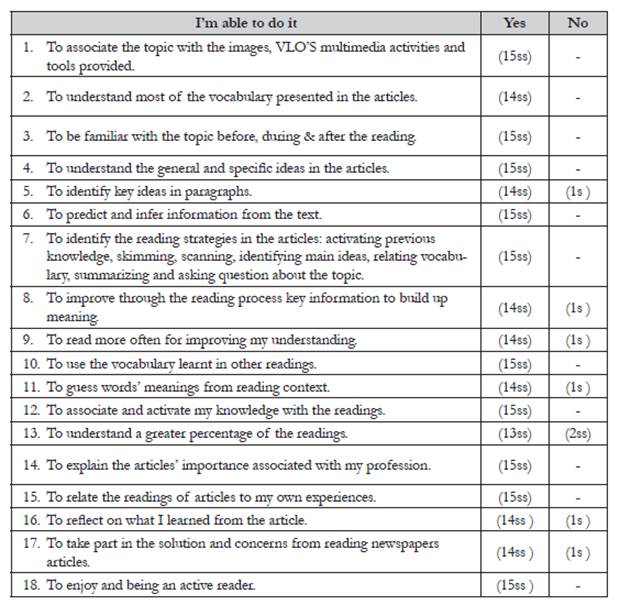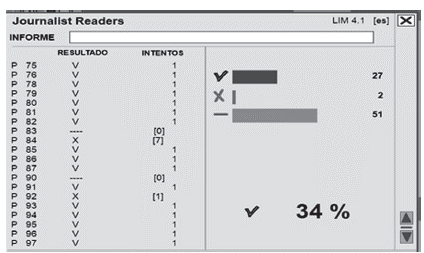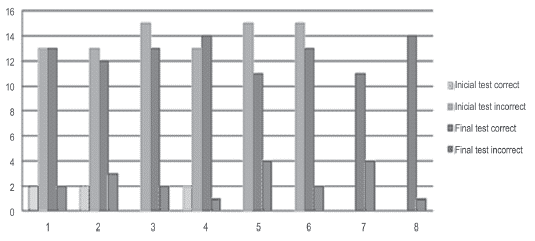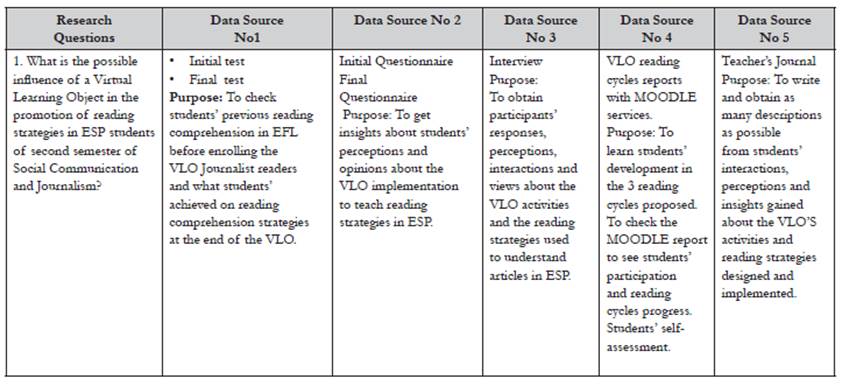Introduction
Teaching faces different challenges in this era of Information and Communications Technology (ICT). One of them is the necessity to meet the demands of the information society and the adaptation of learners to work in an ICT environment. This passes by the tasks of providing prompt and friendly access to information. For this purpose, going beyond the language classroom walls can be achieved with the implementation of innovative ICT proposals that promote learners' reading competences and strategies. The sustained insertion of new technologies in the field of ELT has been documented by Lopera-Medina (2014). In addition, Clavijo Olarte, Hine, & Quintero (2008) suggest that Virtual Learning Objects (VLOs) have proved to be dynamic, flexible, and cooperative and personalized vehicles to promote strategies for learning foreign languages in virtual environments, specifically reading strategies.
This paper reports the findings of an intervention carried out in a private institution of higher education in Bogota, Colombia. Despite the instruction and exposure to content in English for freshmen students of Social Communication and Journalism using ESP (Suárez-Montes & Díaz-Subieta, 2015), students fail to comply with the English language requirements of the university, especially the ones related to their competences in reading in this target language. This evidence is reported taking into account a data triangulation plan (Sagor, 2000), which indicates the use of different perspectives to support the findings and collect the information (see Appendix). In this fertile scenario for innovation, a VLO was proposed for an ESP course as an alternative to promote and find evidence of the sustained use of reading strategies.
VLOs have become one of the most important modalities to further reading comprehension in universities. Nappa and Pandiella (2012) explain that VLOs and web resources provide many benefits for language learners. They develop skills for reading; they encourage independent learning and transfer English language content interactively. Students can communicate, exchange ideas, and work with other classmates through different activities (Nappa & Pandiella, 2012).
Additional research presents the VLO as a means to motivate students and build their self-confidence provided that it offers interaction, individualized instruction, and teacher support. There are other advantages to the VLO; for instance, Muñoz Arteaga et al. (2006) highlight important upsides of these web resources such as accessibility, flexibility, reusability, durability, educability, interactivity, and adaptability, which refer to the practices and procedures used in the actual teaching moment. These upsides were all considered in the current study.
Similarly, Barraza (2014) conducted a qualitative study which demonstrated that strategies enhanced reading through the utilization of a Virtual Lab. Aspects such as reading learning experience, effectiveness, interactive activities, and graphic organizers not only improved comprehension but made it enjoyable and practical.
In Colombia, the implementation of virtual tools for EFL has been a quintessential alternative to excel language learners' L2 competences. The use of ICT to read and write in college (Castillo, 2017), web-based courses fostering reading strategies namely, prediction, skimming, and scanning (Osorno-Gonzalez & Lopera-Medina, 2012), as well as Cross-cultural Virtual Forums displaying students' cultural stories by integrating reading activities and consolidating vocabulary (Clavijo Olarte, Hine, & Quintero, 2008), exemplify the headway of virtual resources in the EFL local context. Considering the insights in these studies, the research question to answer in the current study is: What is a possible influence of a VLO in the promotion of reading strategies in ESP students of second semester of social communication and journalism? The following sections provide a description of the procedures to obtain an answer to this question.
A Virtual Learning Object (VLO) to Teach Reading Strategies
This segment discusses conceptual and theoretical considerations that underpin the study reported in this paper. A Virtual Learning Object (VLO) can be understood as a pedagogical mediator intentionally designed for a learning purpose. Arias-Soto, Buitrago-Escobar, and Pineda-Báez (2011) define it as "a vehicle for providing authentic material for the student to have contact with real language" (p. 35). In addition, these authors highlight other benefits such as the development of reading skills in EFL and self-confidence in students. In the same vein, Wiley (2002) considers that VLOs allow the transit of learning models based on the construction of knowledge that permits the implementation of an intelligent teaching-learning environment. VLO acts as a useful device with its objectives and plans with which learners can mutually interact, learn, and propose their ideas.
As far as the advantages of incorporating interactive and technological strategies for ESP reading, Barraza (2014) suggests that they encourage independent learning by developing analysis and reflection, clarifying doubts, and transferring content, all of which can be used as control mechanisms and self-assessment. On the other hand, Wiley (2002) argues that those strategies help learners to expand the cognitive skills that they use to understand, select, organize, develop, and interpret the information they find in the VLO web resource. Overall, these aspects suggest that VLOs are more relevant in teaching and learning practices when the content and virtual functional quality are presented in a more attractive way for students to start working on reading activities.
Reading Comprehension in EFL
Neufeld (2005) understands reading as a process of making meaning in which there is a constant problem-solving exercise demanded by the interaction between the reader and the text. For Koda (2005), it entails "converting print into language and then to the message intended by the author" (p. 4). For Hellekjaer (2009), reading "comprises decoding the written text on the one hand and efficiently processing the information on the other hand" (p. 200).
Departing from the aforementioned conceptions of reading, Koda (2005) argues that comprehension happens when readers extract and process different information from the text and integrate it with their knowledge of the world. In this sense, reading constitutes a meaning-making process of constructing a supportable understanding of a text (Neufeld, 2005). Neufeld highlights two features in this comprehension process. First, seeking to comprehend a text is an active, intentional thinking process through which the reader constructs meaning. Second, during students' understanding of a text, this process varies because of their background knowledge and experiences. Thus, the reader attends to the information in the texts -encodes it- and constructs meaning through interaction and involvement with it. What the learner does to comprehend, encode, retrieve, and recall information is recognized as strategies, which are essential in reading development (Pang, 2008; Castillo, 2014).
For Snow Chair (2002), reading constitutes a heuristic comprehension process situated in a socio-cultural context and shaped by students' experiences, cultural practices, and background knowledge. Meaning construction entails transactions among the reader, the text, and the tasks; these change in the micro-developmental processes of pre-reading, during- reading, and post-reading, which show the transition of what the reader brings to the text and what they take from it.
Two fundamental reasons support this model. First of all, the variety of reading strategies that the model offers allows students to become active and purposeful readers able to monitor their own reading comprehension process. For instance, when students interact with the text, they recognize new vocabulary, organize and evaluate information, and establish connections with their own socio-cultural context; this shapes their background knowledge. A second reason is that reading strategies can be integrated to help learners understand specialized articles and texts in ESP. Each element of this micro-developmental process (the reader, the text, and the activity) interweaves and integrates one to another in permanent interaction.
Reading strategies should be practiced, reinforced, and refined continually. They are based on the complexity and extensiveness of the text that the individual is reading. These parameters become an alternative to tackle difficulties in the reading practice in ESP classrooms, as suggested in this paper. Drawing on Snow Chair's (2002) reading model, this current research study presents a proposal for teaching reading strategies in an ESP class. As Snow Chair (2002) suggests, by using different kinds of texts and tasks, the strategies applied were selected according to the students' ages, their conditions and needs.
Reading processes in English for Specific Purposes. According to Dudley-Evans and St. John (1998), reading in ESP is an approach centered on students' needs and interests to empower them to manage their understanding of technical and discipline-related texts. For Hutchinson and Waters (2005), ESP meets the learners' needs and reasons for learning, which determine the method and content to work in class. Likewise, Dhieb-Henia (2008) explains that ESP should provide learners with different types of activities to help them deal with the texts proposed. All of this facilitates two main processes: acquiring vocabulary and content, and establishing a dynamic interaction with further applications of knowledge. VLO would serve those purposes by integrating interactive resources such as videos, games, and animations.
In the current research study, VLOs constitute a pivotal variable since the virtual alternatives provide engaging learning experiences with contents of interest to audiences. The study then hopes to contribute to discussions on designing and implementing context-sensitive the VLO as a pedagogical mediation giving the potential that virtual tasks offer to enhance and monitor language development.
Method
The study employed representative features of a descriptive qualitative case study. It was based upon a problem previously identified (Merriam, 2009): a group of English students' failure to comply with reading competence objectives for an ESP course. The study is also situated in a specific setting, a private institution of higher education in Bogotá, with a group of fifteen second-semester students majoring in social communication and journalism who were taking an ESP course at the same institution, and whose ages ranged between 16 and 24 years. This characteristic relates to the case study paradigm as a bound system (Yin, 2014). For Hernández-Sampieri, Collado, & Baptista-Lucio (2014), qualitative research focuses on "The understanding and deepening of the phenomena [...] in a natural environment and in relation to the context" (p. 364). Accordingly, one of the main reasons for engaging in qualitative research was to address a specific situation that could bring about relevant transformative outcomes to the participants involved and to the educational setting in general.
The data informed both what happened when a VLO was introduced and the manner in which the 15 participants felt about what happened in the VLO. The emerging categories established the results of the study that revolved around the possible influence of the VLO in the promotion of reading strategies in the participants. Thus, data from the reports of the VLO reading cycle provided information to understand the participants' language development and their self-assessment at the end of the three cycles.
In addition, the responses to the questionnaire provided the insights that the participants gained from the activities and strategies of the VLO (Corbin & Strauss, 2008). The semi-structured interview (Merriam, 2009) captured the participants' perceptions and reasoning of what happened in the VLO, as well as tracked the most relevant strategies that informed their work with the VLO.
Implementation of a Virtual Learning Object in ESP
The VLO was designed using free software named EDILIM. The tool had 99 pages, which contained three reading cycles, each including a variety of texts about the cinema, movie directors, entertainment, design, and topics related to the participants' major. There were interactive activities with puzzles, crosswords, and word search for promoting reading strategies in ESP (Snow Chair, 2002). These contents and activities derived from the diagnostic assessment in which participants expressed their preferences and took into account their English language proficiency level. Similarly, most of the students who participated in this stage of the design of contents and activities considered it relevant for strengthening their reading strategies through online activities. In sum, both contents and purposes were articulated with Wiley's (2002) premises of quality for a virtual object, which should follow "a set of requirements that need[s] to be measured according to the needs of its users" (p. 117). The design of the VLO also considered the three elements proposed by Snow Chair (2002), namely the reader, the text, and the activity. The three elements intrinsically related to the participants' contexts. This followed the principle that elements are interwoven with three micro-developmental processes called, pre-reading, while reading, and post-reading.
VLO adjustments came after a piloting stage, which informed aspects of refinement in the VLO. As the researcher and developer of the implementation of this study, I acquired self-confidence and improved my abilities in designing and applying the data collection instruments. At the same time, the information that I gathered throughout the piloting served to sustain the pedagogical intervention (Merriam, 2009). Once the final version of the VLO was done, it was uploaded onto the Internet (http://itaemoodle.pedagogica.edu.co/). Then, it was implemented with the participants to facilitate the strengthening of reading strategies.
The lessons were organized in three cycles considering aspects such as objectives, reading-author(s), grammar, vocabulary, reading strategies, and assessment (Lopera-Medina, 2014; Craven, 2003). The students could recall and identify the reading strategies through self-assessment checklists presented in each reading cycle. This self-assessment in turn helped them monitor their reading progress. The three cycles were designed as follows:
Cycle 1 contained three simple short newspaper articles about cinema directors and entertainment; the students needed to identify details and build up meaning. Cycle 2 contained topics about magazines and Netflix productions. Finally, Cycle 3 included articles about the role of the radio and the importance of protecting journalists in Colombia. Hence, after participating in the previous two cycles, the students could take part in the solution to problems presented in the articles. Finally, final tests were designed to check students' reading comprehension of the topics and the use of the reading strategies suggested in the VLO.
The chart describes the organization of the VLO with a variety of tools associated with the students' field of action. I carefully designed and selected each of the readings, images, and activities to secure a good experience for the students. Information was presented with the main goals and instructions being to promote participation in an organized and sequential way. The tool displayed an array of options such as access to links, videos, dictionaries, and an online translator in order for students to make the most of their virtual learning process in ESP.
Results
Data collected through VLO reading cycle reports, questionnaires, and the semi-structured interviews were analyzed through Sagor's (2000) 'coding data for analysis strategy.' This consisted of reading information, sorting it according to themes, and organizing it into codes and categories. For this particular study, I established a connection between the data and findings simultaneously. The units of analysis were identified in data by identifying the smallest but significant pieces of data that lead to finding patterns (Merriam, 2009). At the same time, I established a connection with the data and findings in order to identify hidden information. For the interviews especially, I used content analysis to interpret the participants' answers and to identify themes or patterns in them (Powers & Knapp, 2006). The emerging categories (the VLO as a mediator for reading, reading strategies employed by the students, and VLO reading strategies as a facilitator in reading comprehension) constituted the possible influence of the VLO in the promotion of reading strategies in the participants.
The VLO as mediator for reading strategies development in ESP. Nappa and Pandiela (2012) argue that the actual mediation of virtual tools increases interaction with texts while learners achieve an independence to read which would not otherwise be possible. Virtual tools also contribute to honing their sight word vocabulary, fluency, and management of new information, all of which are crucial for improvement in reading comprehension (Assia, 2012). The 15 participants interacted with multimedia activities in the VLO that allowed them to become familiar with ways to approach the texts. In the data obtained from participants, they identified a connection between the VLO and the activities that involved reading strategies. Thus, topics as "tools that enhance reading processes" (in the questionnaire) and "tools that enhance understanding" (questionnaire and interview) derived from the students' experience with the tool.
S11: "I had never done reading activities online, which allowed me to learn new topics in English and fostered my confidence when reading."
S13: "I had the opportunity to learn more about topics related to my profession by means of doing different readings and activities." [Question 1 - Questionnaire and Interview]
Student 6: "The VLO was beneficial to know topics of great importance for my profession, helping me to learn new things." [Interview Question 13]
The data show that the VLO played the role to mediate for interaction between the participants and the texts evident through the way the students acknowledged the learning potential of the readings deployed in the virtual tool. Additionally, since the students were able to regulate their own reading process (Dhieb-Henia, 2008), more possibilities to gain confidence developing the reading practice in this alternative mode was evident too.
In the two last excerpts extracted from the interventions of students 13 and 6, the connection between the reading contents proposed in the VLO and the professional context of the readers was perceptible. As stated in the literature review, the students then established connections with their own socio-cultural context by interacting with virtual texts, then shaping their background knowledge (Snow Chair, 2002).
Reading strategies employed by students in the VLO. The reading model chosen for this study worked as an umbrella frame for the implementation of reading strategies. Reading was conceived as a constructive, meaning-making process that involved the interconnection of four main elements: the reader, the text, the activity, and the context. It had to do with the reading strategies proposed by the Reading Study group (Snow Chair, 2002). The strategies were integrated through the following reading processes: before reading, during reading, and after reading. The data collected through the Moodle self-assessment report showed the following list of reading strategies that the students were aware of employing during the three cycles.
Table 3 shows the recurrence of using 17 identified strategies by the students. The column "yes" shows the number of students who used the strategy. The students exercised all of the reading strategies at some point of the process within each of the three cycles. I contend that getting familiarized with the VLO contents and dynamics, then using the integrated tools (videos, links, and presentations to orient the student) were of paramount importance for the achievement of this result.
In the interview conducted with the students at the end of the process, they could notice that the activities proposed had a purpose in each cycle. That purpose was articulated with the reading strategies as general guidelines, oriented to have the students find out how to read and answer reading comprehension questions in a specific article.
S6: "The Reading strategies promoted by the VLO were effective because they guided us a lot. They are like guidelines on how to read in every moment, before, during and after reading and answer the questions in the article."
Interview- Question 5: What are the strategies you found more useful?
S7: "Activation of previous knowledge, skimming, scanning, predicting, main idea identification, vocabulary association, concluding and making questions about the article." [Questionnaire and Interview]
The data collected in the final questionnaire showed that the students learnt how to read and understand a text in English by using reading strategies, as these allowed them to understand the articles better. VLOs are generally conceived to have added values in the teaching and learning process in ESP, since the participants benefited from the possibilities these tools offered. Some of these were practicing with readings and related activities to discover reading strategies that fostered reading comprehension of specialized texts in English.
VLO reading strategies as facilitator in reading comprehension. Reading comprehension is the process of capturing and constructing meaning from a text; in this case, a written text included in the VLO. It is the result of the interaction that occurs when the text itself, the reader, and the context interweave (Neufeld, 2005). Speaking of the text itself, I highlight the fact that the students were able to tap on the design and approach used to distribute readings in the VLO, namely, the organization by cycles and the micro-developmental processes (pre-reading, during-reading, and post-reading).
The students learned how to read and understand a text in English by using the reading strategies abovementioned, as these allowed them to understand the articles better. The following excerpts demonstrate how the VLO equipped them with tools to understand the texts presented.
S8: "The strategies were necessary to comprehend texts more accurately, starting from the 'before Reading' part. That allows approaching better to the text and they are good to improve vocabulary and be able to draw conclusions about the Reading."
S9: "The Reading strategies allowed me to make meaning of the topics, to see what the author wants to convey."
[Interview Question 13 - Questionnaire and Interview]
The incorporation of the VLO highlighted the fact that both the teachers and students worked in a friendly environment that benefited their practices, and enhanced the pedagogical expertise and engagement with learning (Beatty, 2012). With the VLO, the participants expanded knowledge and practiced English more in interactive activities such as puzzles, games, crosswords, and word search, among others. The participants expressed that, with the strategies, they learned to navigate through activities and were able to map the texts.
With respect to the VLO cycles, the participants were able to identify details and build up meaning from texts in the first cycle. In cycle two, the participants practiced to increase their capability to understand newspaper articles, and, in cycle three, the participants proposed solutions to the issues presented in the newspaper articles. The data in Figures 1 and 2 below, extracted from the VLO reading cycle reports with Moodle, contrasts the total of correct answers to reading comprehension requirements.
Figure 1 shows the students' progress in their comprehension abilities. Only one participant resorted to seven tries, but all of them could do crosswords, sentence-matching, and word search to check understanding on their own. This flexibility was not available in direct classroom instruction. The participants took an initial test before the pedagogical intervention and a final one after it. Figure 2 contrasts those results to shed light on the effectiveness of promoting reading strategies to comprehend written texts in ESP mediated by a VLO.
The graphic of the initial and final tests provides a picture of the significant difference between the results that the students obtained before and after the implementation of the VLO. This shows that the students could have taken advantage of the use of reading strategies when dealing with newspaper articles in ESP. Consequently, the participants showed an overall increase in the outcome in reading comprehension. Regarding the objectives of the test, these results suggest that the students, over time, become more equipped with the linguistic competences they need in their professional life as social communication or journalism students.
Conclusions
According to the results presented in this paper, VLOs serve to promote reading strategies for ESP courses. That promotion depends greatly on the way VLO resources are deployed, which in this study meant setting manageable learning objectives, grading and selecting texts and topics that are sensitive to the learners' needs, and including an informed selection of engaging games and activities. In this manner, VLOs mediate and ease interaction between students, teachers, and texts. This paper postulates that the development of reading strategies constitutes the core of a successful pedagogical intervention and that the support of VLO contributes to it. The results presented above attest to the participants' efforts of meaning-making
Furthermore, these results showed that the students became aware of the importance of the reading strategies promoted by the VLO in order to understand better the process involved in interpreting newspapers and academic texts. This happened with the use of strategies such as activating previous knowledge, skimming, scanning, inference, or drawing conclusions. The increase in comprehension can be attributed to the work done on the VLO. The final reading test showed the progress in understanding the texts.
The participants also strengthened their knowledge and the strategies necessary to tackle academic and scientific texts. They were able to recall and identify reading strategies in the self-assessment checklists of each report of the VLO reading cycle. The evidence gathered from the reports in the Moodle platform of the course consisted of the participants' self-assessment and the work done in the three cycles monitored by the teacher. The participants coped with the difficulties found in terms of the appropriation of the concepts and resources presented in writings. Consequently, this enhanced their linguistic repertoire for coping with articles and reports on social communication and journalism. This assertion derives from the contrast of the students' responses in the interviews, questionnaires, and reports at the beginning and at the end of the implementation.
Upon analyzing the data of the VLO's implementation there was evidence that the participants followed the reading sequence proposed by Snow Chair (2002) for before, during, and after the reading; this was manifested in interviews. The proposed reading sequence acted as an interconnecting method and a promoter of specific orientations that determined somehow the reading process that participants underwent when using the VLO.
From the intervention with the VLO in this population, it can be inferred that the use of reading strategies promoted by the VLO went a long way in establishing connections between the students' own socio-cultural context and texts, thus enhancing their background knowledge. In this respect, it can safely be claimed that VLO provided learners with tools to facilitate and enrich their overall reading and learning experience.













